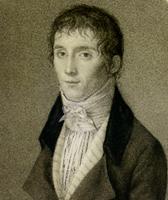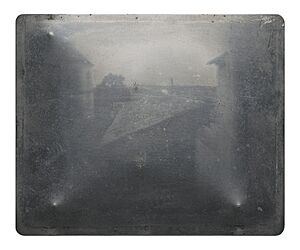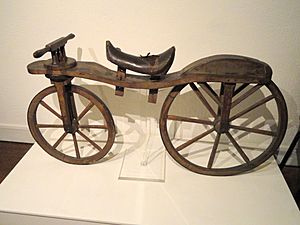Nicéphore Niépce facts for kids
Quick facts for kids
Nicéphore Niépce
|
|
|---|---|
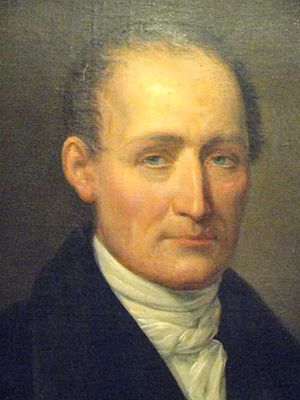
portrait circa 1820
|
|
| Born |
Joseph Nicéphore Niépce
7 March 1765 |
| Died | 5 July 1833 (aged 68) Saint-Loup-de-Varennes, Saône-et-Loire, France
|
| Occupation |
|
| Years active | 1795−1833 |
| Known for |
|
| Signature | |
 |
|
Joseph Nicéphore Niépce (born March 7, 1765 – died July 5, 1833) was a French inventor. He is often given credit for inventing photography. Niépce created a method called heliography. He used it to make the world's oldest surviving photographic print in 1825. This print was made from a photo-engraved plate.
Around 1826 or 1827, he used a simple camera to take the oldest surviving photograph of a real outdoor scene. Niépce also invented the Pyréolophore. This was one of the first internal combustion engines ever made. He developed it with his older brother, Claude Niépce.
Contents
Biography
Early Life and Education
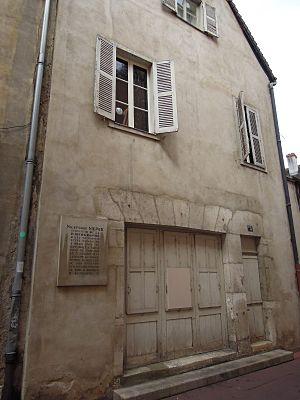
Nicéphore Niépce was born in Chalon-sur-Saône, France. His father was a rich lawyer. Nicéphore had an older brother, Claude, who helped him with his inventions. He also had a sister and a younger brother, Bernard.
Nicéphore was baptized Joseph. But he later chose the name Nicéphore. He did this to honor Saint Nicephorus, a religious leader from the 800s. He studied at a college in Angers. There, he learned science and how to do experiments. He quickly became a professor at the college.
Time in the Military
Niépce served as an officer in the French army under Napoleon. He spent several years in Italy and on the island of Sardinia. However, he became ill and had to leave the army. After that, he married Agnes Romero. He then became an administrator in the district of Nice in France. In 1795, he left this job to focus on scientific research with his brother Claude.
Scientific Discoveries
In 1801, Nicéphore and Claude went back to their family's home in Chalon. They continued their scientific research there. They lived as wealthy farmers, growing beets and making sugar.
His Brother Claude
In 1827, Niépce traveled to England to visit his older brother Claude. Claude was very sick and living near London. Claude had become unwell and had wasted much of the family's money. He spent it trying to make the Pyréolophore a big business success.
Death
Nicéphore Niépce died on July 5, 1833, after having a stroke. He had lost so much money that the town had to pay for his grave. His grave is in the cemetery of Saint-Loup de Varennes. This is near the family house where he did his famous experiments.
His Family's Legacy
His son, Isidore (1805–1868), worked with Louis Daguerre after Nicéphore's death. In 1839, the government gave Isidore money each year. In return, he shared the details of his father's heliography process.
His cousin, Claude Félix Abel Niépce de Saint-Victor (1805–1870), was also a chemist. He was the first to use egg whites (albumen) in photography. He also made photographic engravings on steel. From 1857 to 1861, he found that uranium salts give off invisible radiation.
Achievements
The Invention of Photography

We are not sure exactly when Niépce started his first photography experiments. He became interested because of a new art form called lithography. He realized he wasn't skilled enough at drawing for it. He also knew about the camera obscura. This was a tool that helped artists draw. It was popular in the late 1700s and early 1800s.
The camera obscura made beautiful, but temporary, "light paintings." This inspired many people, including Thomas Wedgwood and Henry Fox Talbot. They wanted to find a way to capture these images permanently.
Around 1816, Niépce wrote letters to his sister-in-law. These letters show he had managed to capture small camera images. He used paper covered with silver chloride. This made him one of the first to have any success. But the images were negatives. This meant dark areas looked light and light areas looked dark. He also couldn't stop them from turning completely dark when exposed to light.
Niépce then looked at other things that changed when exposed to light. He finally focused on Bitumen of Judea. This is a natural asphalt that had been used for a long time. In Niépce's time, artists used it to coat copper plates for etchings. Artists would scratch a drawing through the coating. Then, they would put the plate in acid to etch the exposed parts. After that, they would remove the coating with a solvent. They then used the plate to print copies of the drawing on paper. Niépce was interested because the bitumen coating became less soluble after light hit it.
Niépce mixed bitumen with lavender oil. This oil was often used in varnishes. He then put a thin layer of this mixture onto a lithographic stone or a sheet of metal or glass. After it dried, he placed something like an engraving (a printed picture) on top. He made sure it touched the surface closely. Then, he put both in direct sunlight.
After enough time in the sun, a solvent could wash away only the bitumen that had been protected from light. This was the bitumen under the dark lines or areas of the picture. The parts of the surface that were now bare could be etched with acid. Or, the remaining bitumen could be used for lithographic printing.
Niépce called his process heliography. This word means "sun drawing." In 1822, he used it to create what is thought to be the world's first permanent photographic image. It was a copy of an engraving of Pope Pius VII. But it was later destroyed when Niépce tried to make prints from it. The oldest surviving photographic items by Niépce are from 1825. They are copies of a 17th-century engraving of a man with a horse. Another is of a woman with a spinning wheel.
These are just sheets of paper printed with ink, like normal etchings. But the plates used to print them were made photographically by Niépce's process. They were not made by hand-engraving. They are like the first photocopies. One print of the man with a horse and two prints of the woman with the spinning wheel still exist.
Niépce's letters to his brother Claude show that he first successfully used bitumen to make a permanent camera photograph in 1824. That photograph, on a lithographic stone, was later erased. In 1826 or 1827, he photographed the same scene again. It was the view from a window in his house. He used a sheet of pewter coated with bitumen. This picture still exists and is the oldest known camera photograph.
This famous image was thought to be lost in the early 1900s. But historians Helmut and Alison Gernsheim found it in 1952. People usually say it took eight or nine hours to expose. This idea came from the fact that the sun lights buildings on opposite sides. This suggests a day-long exposure. A later researcher used Niépce's notes and materials to recreate his process. They found that it actually took several days of exposure in the camera to capture such an image well.
In 1829, Niépce started working with Louis Daguerre. Daguerre was also trying to create permanent photographic images with a camera. Together, they developed the physautotype. This was an improved process that used lavender oil as the light-sensitive material. Their partnership lasted until Niépce died in 1833. After that, Daguerre continued to experiment. He eventually created a process that was only a little like Niépce's. He called it the "daguerréotype" after himself.
In 1839, Daguerre convinced the French government to buy his invention. The government agreed to pay Daguerre 6,000 francs each year for the rest of his life. They also agreed to pay Niépce's family 4,000 francs each year. Niépce's son was unhappy about this. He felt Daguerre was getting all the credit for his father's work. In many ways, he was right. For many years, Niépce did not get much credit. Later historians have brought Niépce's work back into the spotlight. Now, it is generally agreed that his "heliography" was the first successful example of what we call "photography." This is making a lasting image using light on a light-sensitive surface.
Even though it was ignored at first, Niépce's original process was useful. From the 1850s into the 1900s, a thin layer of bitumen was widely used. It was a slow but very good and cheap material for making printing plates.
The Pyréolophore Engine
The Pyréolophore was likely the world's first internal combustion engine that was actually built. The Niépce brothers invented and patented it in 1807. This engine ran on controlled explosions of lycopodium powder (a type of dust). It was put on a boat that sailed on the Saône river. Ten years later, the brothers were the first to make an engine work with a fuel injection system.
The Marly Machine
In 1807, the government held a competition. They wanted a new machine to replace the original Marly machine. This machine brought water to the Palace of Versailles from the Seine river. The old machine was built in 1684. It pumped water one kilometer and lifted it 150 meters high. The Niépce brothers came up with a new way to make the machine work. They improved it again in 1809. Their machine had better parts, like more precise pistons. This made it work with much less resistance. They tested it many times. With a water drop of about 4 feet 4 inches, it could lift water 11 feet. But in December 1809, they learned they had waited too long. The Emperor had decided to ask engineer Périer to build a steam engine for the Marly pumps instead.
The Vélocipède
In 1818, Niépce became interested in the ancestor of the bicycle. This was a Laufmaschine invented by Karl von Drais in 1817. Niépce built his own version and called it the vélocipède. This means "fast foot." It caused quite a stir on the local country roads. Niépce improved his machine with an adjustable seat. It is now on display at the Niépce Museum. In a letter to his brother, Nicéphore even thought about adding a motor to his machine.
Legacy and Commemoration
A lunar crater, Niépce, is named after him.
The Niépce Heliograph is always on display at the Harry Ransom Center at the University of Texas at Austin. Historians Alison and Helmut Gernsheim found the object in 1952. It was sold to the Humanities Research Center (now the Harry Ransom Center) in 1963.
The Niépce Prize is given out every year since 1955. It honors a professional photographer who has lived and worked in France for over three years. Albert Plécy of the l'Association Gens d'Images created it to honor Niépce.
See also
 In Spanish: Joseph Nicéphore Niépce para niños
In Spanish: Joseph Nicéphore Niépce para niños
- Timeline of photography technology
- Timeline of transportation technology
- History of the internal combustion engine
- François Isaac de Rivaz
- Janine Niépce, photographer
- List of works by Eugène Guillaume


